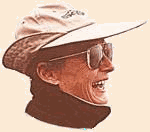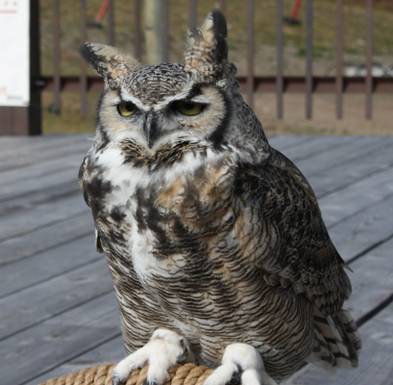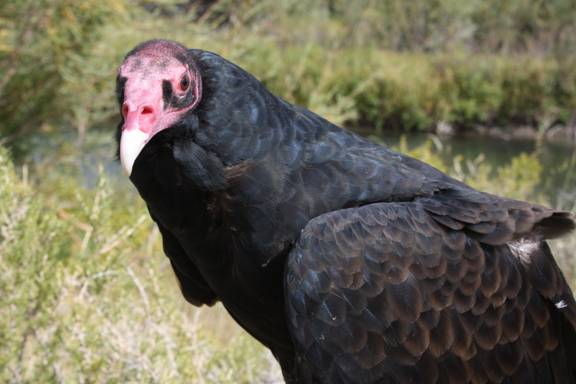- You are here:
- FAOL Home >>
- Articles >>
- Ladyfisher
 |
from Deanna Travis FlyAnglers Online Publisher & Owner |
IT'S A BIRD, IT'S A PLANE!
There's nothing like walking in the door of the gym and staring into the face of a live Swainson's hawk to get ones attention. On the stage behind the hawk were three large pet carriers which had their doors 'blacked' out with tape. The gal giving the program later explained the birds were calmer in the dark so they made a habit of traveling with them that way.
The program was one of four we attended recently celebrating International Migratory Birding Day - all presented under the auspices of the local Forest Service offices in Livingston Montana. The idea of course is to educate the public about all manner of birds; bird watching is currently listed as one of the most popular pastimes in America. My husband Trav is always surprised at how few people are willing to spend a couple hours on a weekday evening to attend a free program which will greatly enhance the birding experience, but the attendance was up for this one, probably because of the promise of live birds.
And indeed they were there; the ambassador raptors from the Montana Raptor Conservation Center (MRCC) in Bozeman. You might recall Trav received a phone call last summer from the city cemetery workers who had found a large owl sitting on the ground under a sprinkler, soaking wet, who was not responding to anything. We picked it up and transported it to the MRCC.
Here are the Ambassador raptors we saw:

"Chaco is a nine year old, male Swainson's Hawk. Swainson's hawks weigh between one and one half to two pounds, with a wingspan of forty-eight inches and a length between seventeen and twenty-three inches.
Chaco was found as a fledgling outside of Great Falls, Montana in September of 2001. He has a congenitally deformed left humerus, which prevents his ability to fly, thus making him un releasable.
Swainson's hawks are summer residents of grasslands and agricultural habitats in the western United States and Canada. They nest in trees and shrubs and lay two to three eggs in a fairly flimsy stick nest. The entire population is migratory and travels great distances to winter in South America- primarily Argentina.
Swainson's Hawks prey on small mammals and occasionally on other birds. They also eat insects on a regular basis and have been deemed "the farmer's friend" because of this proclivity.
Chaco's name comes from a province in Argentina where these hawks are known to concentrate in the winter. "

Bu is a Great Horned Owl. He is an adult, male, and weighs about two pounds, with a wingspan of forty-eight inches and a length of twenty-three inches. Bu was found out of the nest as a nestling in March of 1999 in Billings, Montana. He was imprinted by his human caretakers.
When a bird is imprinted, he cannot be successfully released back to the wild, because as the owl matures and looks for food or a mate, it may choose a human. Bu was transferred to MRCC in August of 1999 to become an ambassador for his species.
Male and female Great Horned Owl plumages are very similar; however, the overall size, behavior and vocalizations can assist in differentiation of the sexes.
Great Horned Owls begin nesting in February and often use stick nests made by other birds, such as hawks, crows and herons. They also use tree hollows, cliff cavities, or broken-topped snags. Two to three eggs are laid each year and incubated for 30-35 days. Nestlings are cared for by both parents and fledge when they are nine to ten weeks old.
Great Horned Owls have large, yellow eyes to help bring in as much light as possible at night. Because their eyes are fixed in the sockets, they must turn their heads to look for predators or prey. Owls can turn their heads two hundred seventy degrees, or about three quarters of the way around.

"Pilgrim is an adult female turkey vulture. She weighs four pounds, has a wing span of seventy inches, and is thirty inches in length. Pilgrim was found beneath a power line in Whitehall, Montana in October of 1993.The wrist and elbow joints of her left wing were severely traumatized. She is non-releasable due to the irreparable wing damage and inability to sustain flight.
Turkey Vultures have exceptional soaring abilities and can travel great distances in search of carrion. To identify turkey vultures in flight, look for a two-toned gray and black under wing and a strong dihedral (upward "V") wing position. Because of their large wingspan and light body weight, vultures have a characteristic rocking motion while in flight.
Vultures keep the environment clean with features that allow them to consume carrion (dead meat)- an un feathered head, a long neck, large nostril openings for odor detection, a sharp, hooked beak for tearing food, and flat feet for bracing and pulling on carcasses.
Vultures do not construct nests, but will use tree hollows, cliff cavities, or a scrape on the ground to lay one to two eggs.
Turkey Vultures are migratory and can be found in Montana in late spring and throughout the summer."
The quoted descriptions above are from the MRCC website http://www.montanaraptor.org. The community I lived in on the Kitsap Peninsula of Washington state also had a raptor recovery center nearby. Usually these facilities seem to grow out of the need to have a place which provides veterinary and rehabilitative care for injured birds of prey. And usually a Veterinary (Dr. Karyn Cook in Bozeman) is the person who gets the facility going.
The MRCC really stresses the importance of getting an injured bird to care. Here you are asked to contact the MRCC by phone and they have a team of trained volunteers across the state for retrieving injured raptors. Obviously raptors have both very sharp beaks and talons which can do damage.
If you find what appears to be an orphaned raptor before touching or moving it, please contact your local raptor center for further information - if uninjured, it may simply need to be placed back in the nest or tree. It is an untrue old wives tale that handling a bird will keep the parents from reclaiming it. However you do want to wear heavy gloves to protect yourself.
Raptors are an important part of our world - especially for folks who have an interest in the outdoors as fly fishers do. We are probably in a better position to come across injured raptors than the average person. The MRCC absolutely stresses the importance of "Report an Injured Raptor Quickly!"
Raptors are found coast to coast - you could help by doing a search via your phone book or Google for a raptor recovery center in your state. Once you know what and where you can help.
For Montana for example, the one close to us in Bozeman is the only one for the whole state!
I suspect that is probably more common than not. The one here has a network of folks who will pick up injured birds and transport it to Bozeman. One of the listed numbers for reporting an injured raptor here is the State Police. Do a little detective work and see what is available where you live.
The recovery rate on these birds is excellent! You can help.